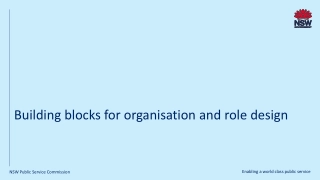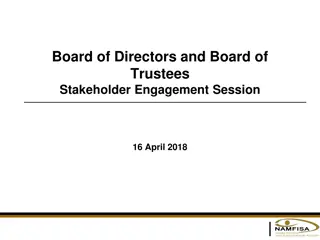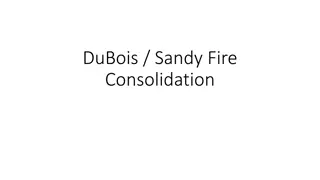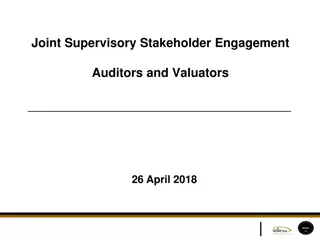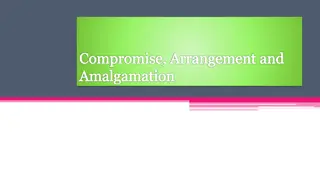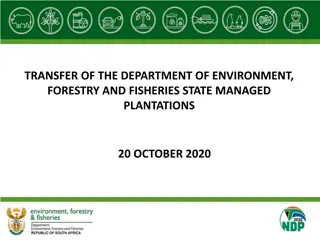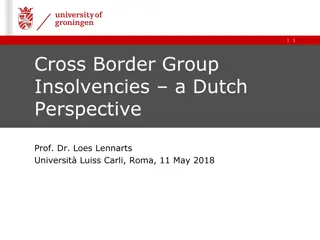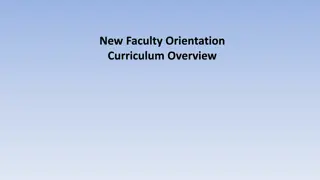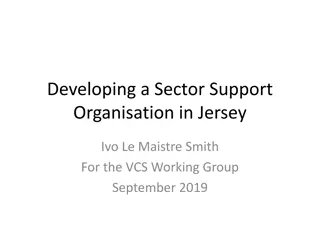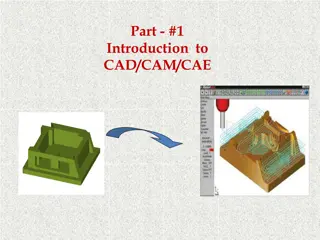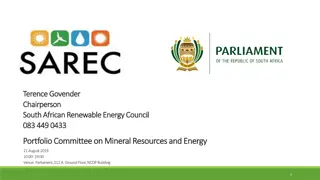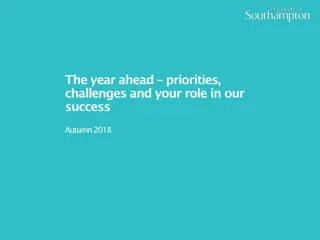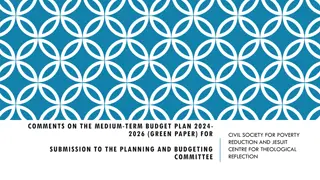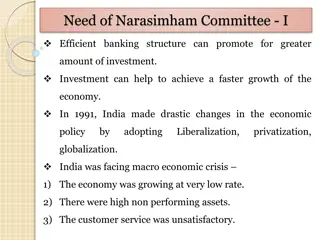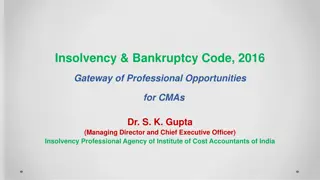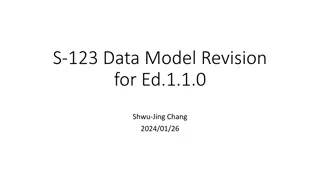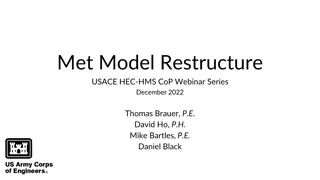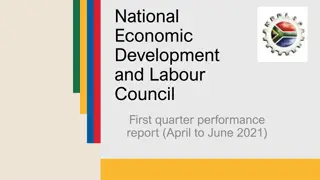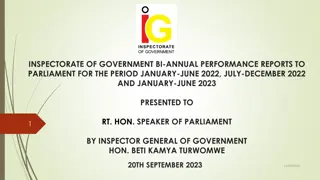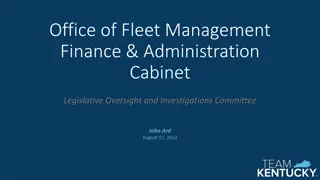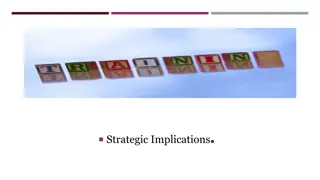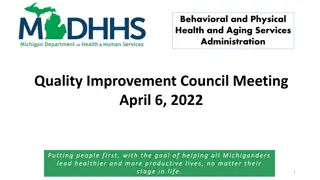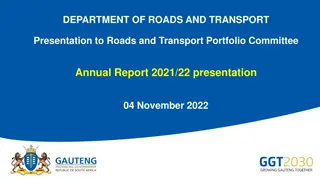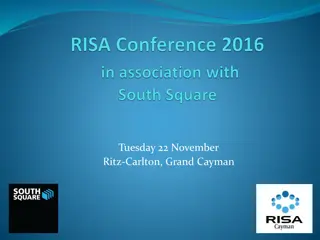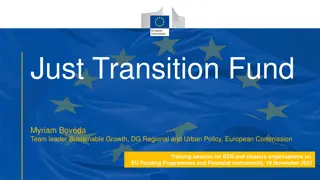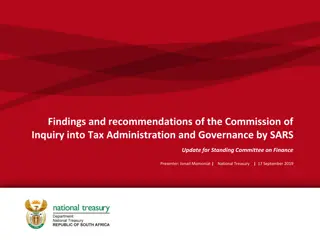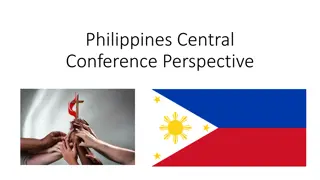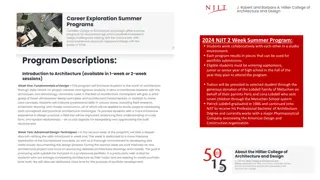Understanding Organisation and Role Design for Effective Restructuring
Organisation and role design are fundamental aspects that drive effective restructuring within an organization. This resource provides insights into the process of organisation redesign, role clarity, and the significance of role design in achieving operational and strategic objectives. It emphasizes the importance of considering various factors such as machinery of government changes, funding availability, organizational strategy, and operating model adjustments when contemplating a restructure. Successful organisation redesign aims to enhance role clarity, foster collaboration, and contribute to a positive workplace culture.
Download Presentation

Please find below an Image/Link to download the presentation.
The content on the website is provided AS IS for your information and personal use only. It may not be sold, licensed, or shared on other websites without obtaining consent from the author. Download presentation by click this link. If you encounter any issues during the download, it is possible that the publisher has removed the file from their server.
E N D
Presentation Transcript
Approach to organisation and role design NSW Public Service Commission 2022
About this resource How to use this resource This resource will help you understand the organisation redesign process, specifically when your senior leader(s) are contemplating a restructure and would like to explore the range of options available. It provides you with key questions to consider at the beginning of the organisation redesign process. This resource is accompanied by other resources including the exploratory discussion tool, situation and approach worksheets, design process, roadmap template and workshop design. About the development of this resource This resource has been developed in partnership with Publicis Sapient, and then further refined in collaboration with Human Resource and organisational change experts across NSW Government. Contact If you have any questions or feedback, or would like more information on this tool, please contact the NSW Public Service Commission on enquiries- psc@psc.nsw.gov.au Enabling a world class public service Public Service Commission 2
What is organisation and role design? Organisation and role design are two sides of the same coin. One informs the other. Organisation design Organisation design is the process that enables the organisation to work well, deliver results, optimise efficiency, achieve operational and strategic objectives. Organisation design determines where roles fit into the broader structure and how each role will interact and intersect with other roles. Role design Elements of organisation design include: structure, systems, processes, delegations, and ways of working. Role design outlines the key responsibilities and challenges of the role, the way the work is to be done, how it will be done, and the capabilities required by the person who will fill the role. Restructure: also commonly referred to as realignment or change management process typically refers to changes to the organisational chart. When preparing for restructures, we need to consider all the aspects of our organisation s design which places our customer at the centre. Organisation redesign Role design is a crucial input to the realisation of the benefits of organisation design. Organisation redesign can take a top down approach (strategy first) or a bottom up approach (role analysis) and is driven by the scale/level of redesign required. Role design plays a vital part in explaining the contribution and value add of the role to organisation operational and strategic objectives. Effective organisation redesign aims to achieve role clarity, collaboration across the organisation, and contribute to a positive workplace culture. Preparing for organisational design and restructures can be challenging. Identifying models and structures that are flexible, adaptable and future-ready requires detailed planning. There are many risks in conceptualising and implementing a redesign/restructure, but there are also many opportunities. Enabling a world class public service Public Service Commission 3
When would you not restructure? When would a restructure be required? A restructure is likely to be done when: Machinery of Government changes result in transfer or merging of organisation functions across clusters There are changes to the source and amount of funding available e.g. budget cuts or expansions When would a restructure be onlypart of the solution? There are changes to the organisation s direction and subsequently the organisational strategy There are changes to the operating model Organisation is adapting to meet new challenges There are changes to the external environment including changes to enabling legislation, the macro environment and community demands The organisation s performance is low and it fails to deliver results expected of them When the workforce requirements increase or decrease for an organisation Advances in technology significantly impacts the value add of the work, employees, services and/or products There are changes to part of the organisations operating model including changes to systems, processes, delegations, and ways of working When would a restructure not be the right solution? There are many reasons why restructures are not recommended to be used, considering the amount of time, expenses and risks involved in implementation. Organisation redesign should not be used: To guarantee improved individual performance. If there are performance issues and the individual is not performing and delivering results and meeting expected standards, then these concerns should be addressed directly. Restructures are about the role not the individual in the role. When a new leader commences To retain a senior staff member to provide them with greater responsibility and authority Restructure is not in itself a tool for guaranteeing improved performance. Where there are questions about an agency s performance, they need to be addressed more directly through a specific purpose review, which can diagnose points of failure or weakness and recommend strategies for improvement. These may, of course, include restructuring. This should be a normal part of government business, and not depend on changes of government or ministerial personnel. (Coaldrake, Peter. Review of culture and accountability in the Queensland public sector. 29 June 2022, page 77). Enabling a world class public service Public Service Commission 4
Approach to organisation and role design Explore Goal: Explore organisational needs to identify if a restructure is the right solution Identify Goal: Identify the objectives, scope and desired outcomes for the restructure Design Goal: Develop the organisational design and implementation plan Identify scope in collaboration with key stakeholders: Develop detailed organisational design Is restructuring the right solution? Refer to the exploratory discussion tool Develop the implementation plan Develop detailed project plan and identify: Activities, roles and responsibilities Key milestones Governance Change management and communication plan Risks and mitigation strategies Step 1: Explore strategic objectives, context and desired outcomes for the restructure. Yes Explore organisational context and needs through an exploratory discussion with key decision makers. No Consider alternatives such as: Organisational efficiency Performance management Capability uplift Culture change Minor adjustment to org structure Minor role adjustments including role creation and realignment Step 2: Identify priorities using the Building Blocks for Organisation and Role Design and determine the approach to restructure Develop new structure Develop the new structure which considers and outlines any changes to: Organisation design Roles Processes Systems Ways of working A decision to restructure would include considering changes to systems, processes, delegations, ways of working, and role design. Step 3: Set the direction for your design decisions and consider any implications. *Note: The Identify stage can be done through workshops, interviews, focus groups or meetings with key stakeholder(s) in your organisation Implement Goal: Implement the new structure using the outputs from the Explore, Identify and Design stages Evaluate Goal: Monitor and evaluate the success of the restructure Enabling a world class public service Public Service Commission 5
What are the building blocks of organisational redesign? The building blocks are fundamental in developing a modern and integrated organisation design.The building blocks are used to identify the scope, inputs, constraints, desired outcomes and critical success factors of a restructure. It will inform the design principles, restructure approach, roadmap and the rationale behind the change. How do I use them? The building blocks should be considered at the beginning of the organisation redesign process. As each organisation is unique, it is important for you to decide which building block you need to spend most of your time on. The building blocks may also be reviewed at key milestones throughout the design process to keep design decisions and activities on track and address any emerging challenges or risks. Key questions are provided on the next couple of pages to guide your review of each building block and determine which areas your organisation needs to focus on. Who needs to be involved? To be effective, organisation and role design should not be seen as just a HR function. It is essential to have support and participation from key stakeholders in the business to explore the building blocks of effective organisation and role design. Once you have identified which building blocks are relevant to your organisation, you will need to identify which stakeholders to engage in the scoping and consultation sessions (Identify stage). As a guide, the following stakeholder groups will need to be involved in the scoping and consultation sessions: Business: senior decision makers and people managers Human Resources: relevant HR Business Partners, and staff in the Organisational Change and Development, Health, Safety and Wellbeing, and Employee/Industrial Relations teams Other subject matter experts: including staff in finance, strategy, risks, data and insights, and governance Enabling a world class public service Public Service Commission 6
Descriptor Enabling a world class public service 7
Building Block 1: Direction Below are some key questions to help you consider the strategic direction of your organisation. Use these questions to focus your design efforts on the right outcomes. Key questions Things to consider Strategy What are the agency s strategic objectives? Consider your agency s vision, mission, business strategies, operating model, fiscal objectives and strategic workforce plan. Customer at the centre Who are our customers? What are our customers saying and doing? What are our customers expectations? Consider human centred design or ways to consult and get feedback from our customers. Culture, values and behaviours What is our culture like? What are our cultural aspirations? What are our agency s values? What behaviours do we need to deliver our operational and strategic objectives? How can we build and maintain our culture? How do our values affect the way change should be managed? How do our values and desired culture impact the way we go about this change? Diversity and inclusion What are our objectives and KPIs for diversity and inclusion? What are the implications for: How the organisation and roles are designed? How change is managed? How does this impact our ways of working? Governance and risks What are our reputational risks? Do we have mitigation strategies to address our risks? Do we have control systems in place to support accountability, compliance and transparency? Do we have a comprehensive approach to corporate governance and managing risks? Enabling a world class public service Public Service Commission 8
Building Block 2: Ways of Working Below are some key questions to help you consider how roles are designed and ways of working in your organisation. Use these questions to identify opportunities to make changes that will deliver on your strategic objectives. Key questions Things to consider Flexible/hybrid Where and how do we work in a way that enables us to meet our objectives and deliver for our customers? What work can be done together or individually and remotely? What do we need to do to support hybrid/flexible ways of working? What strategies could we use to connect our employees working flexibly? Refer to the PSC s flexible working resources and guidance on role redesign for employees How we work together How do we work and collaborate? How does this way of working support our strategic direction? What are the interdependencies between people? How do our teams work together? What happens between the lines on the organisational chart? What are our approaches to work (e.g., human centered design, agile, devolved accountability)? Digital enablers How can we incorporate digital capabilities in the way we design our roles, our recruitment and performance development processes? Are there opportunities to automate or augment tasks to increase employee capacity and improve customer outcomes and experience? What digital enablers, data analytics and artificial intelligence capabilities could help us meet future business needs? Which tasks could be automated or augmented, what would be the impact on resourcing, organisation and role design? What capabilities are needed to support artificial intelligence and the rapid increase of technology? Capabilities and mindsets What capabilities and mindsets do we need to achieve our operational and strategic objectives? What capabilities do we need to build on our achievements? What are the accelerator roles in our organisation that will help us meet our strategic objectives? Enabling a world class public service Public Service Commission 9
Building Block 3: How we are organised Below are some key questions to help you consider how your organisation is organised. Use these questions to consider alternatives to the way your organisation is currently organised. Key questions Things to consider Organisational models What are the benefits and constraints of alternative organisational model options? What is our current organisational model? How well is the current structure enabling achievement of business value and productivity? What is working well in other agencies and organisations that might be able to be applied in our context? Sizing, spans and layers What do we want to achieve with sizing, spans of control and layers? Are critical decisions being made at the right level and in the right business unit? What are the current possibilities and constraints? How can spans of control and layers promote employee engagement, accountability, career paths, wellbeing, flexibility etc? Classifications What role classifications and structure will we need? What are our budget constraints? What role classifications do we need to achieve our strategic priorities? Role descriptions What are the outcomes our roles need to deliver? How can we ensure our position descriptions are designed consistently? How can we incorporate our organisation s direction and ways of working in our role design? Where are the more generalist and/or specialist roles needed, to achieve our strategic workforce and agency outcomes? Enabling a world class public service Public Service Commission 10
Building Block 4: Boundaries Below are some key questions to for you consider the boundaries and constraints your organisation. Use these questions to identify the guard rails that will need to be considered in your design. Key questions Things to consider Workforce and Industrial Relations (IR) Legislative Frameworks What are the current, relevant workforce and IR frameworks or and how will these influence or constrain organisation and role design choices? How will these influence our approach to design and implementation? Are there any opportunities to change these frameworks to help meet our agency s objectives? Does the current classification structure enable or constrain decision-making at the right levels? What rules, constraints or legislative structures guide sizing decisions? Policies, procedures and delegations What policies, procedures and delegations will influence our design choices? Are there opportunities to update our policies, procedures and/or delegations to meet our agency s objectives? Enabling a world class public service Public Service Commission 11
Terms and definitions Term Definition Automation The use of technologies to operate automatically and undertake components of a job or replace a job once performed by a human being. This may cause a need to redefine jobs, redeploy employees or identify areas for reskilling or upskilling. Augmentation The use of technologies to enhance components of a job which provides employees with more capacity to undertake higher value work. This will mean identify areas for reskilling or upskilling. Capabilities Capabilities are the transferable knowledge (theoretical or practical understanding of a subject), skills (proficiencies developed through training, experience, or practice), and abilities (qualities of being able to do something) relevant to a role. Refer to The NSW Public Sector Capability Framework Centralisation In a centralised model, authority and decision making including decisions about work performed are made by the leader of the organisation or central leadership team. Characteristics of a centralised organisational structure is a concentrated authority figure, hierarchical structure, and top-down communication and decision making. A variation of this model is the concept of shared services where specific common functions across business units are centralised and are used and shared across multiple business units. Decentralisation In a decentralised model, each organisational unit undertakes some or all of the common functions or tasks themselves. Decision making and authority is usually more spread out and distributed between a group of leaders / department heads. Operating model An operating model is a representation of how an organisation plans to execute their strategy. It is the bridge between strategy and operations and translates the organisation s strategy to show what the organisation does and how it operates. Enabling a world class public service Public Service Commission 12
Terms and definitions (continued) Term Definition Organisational structure An organisational structure is a system that outlines the roles, relationship of roles, responsibilities, and supervision of the employees of an organisation. An organisational chart includes: position title and number vacant positions reporting lines and structure Department/branch/team agency name Employee name Some common organisational structures include a classic hierarchical structure (with several layers reporting to a central figure), a team-based organisation (teams working together and cross collaborating), and a matrix organisation (employees/teams report to at least two or more managers, and is usually based on project or product delivery). Span of control Span of control refers to the number of employees reporting to a single manager. In organisational structures with more layers, span of control tends to be smaller, however in flatter structures, span of control tends to be wider. Enabling a world class public service Public Service Commission 13


